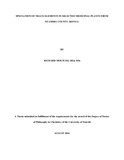| dc.description.abstract | In this study medicinal plants used by herbalist in Nyamira County, Kenya were evaluated and
characterized for their elemental species. Experienced herbalists and the medicinal plants they
use to treat different diseases were assessed. Elemental species in medicinal plants were
determined and correlated to the diseases they treat. A questionnaire was administered to four
hundred herbalists in four Sub-Counties, Borabu, Ekerenyo, Manga and Nyamira that comprise
Nyamira County. Seventy six herbalists in each sub-county were randomly selected using the
questionnaires. The herbalists were established by mapping their clinics using geographical
position system (GPS). A total of three hundred and four medicinal plants were sampled from the
herbalists and analyzed for various trace and macro elements. The questionnaires were analyzed
to establish the demographics and social status of the herbalists, the predominant diseases treated
and medicinal plants used by the herbalists. Total levels of magnesium, copper, zinc, iron,
manganese and chromium in the medicinal plants were determined by flame Atomic absorption
spectrometry using acetylene at 2000oC and inductively coupled plasma- mass spectrometry.
Sequential Extractions was used to fractionate iron, chromium, manganese, zinc and copper in
the medicinal plants. One hundred and sixty herbalists were found to treat predominantly malaria
and diabetes and with high treatment success rates. Twelve medicinal plants were used to treat
diabetes and ten medicinal plants were found to treat malaria. A total of 19 medicinal plants were
used in the treatment of malaria and diabetes. The four mostly used medicinal plants to treat
malaria with 100% usage were Aloe vera, Clerodendrum myricoides, Toddalia asiatica and
Warburgia ugandensis while those used to treat diabetes were Bidens pilosa, Solanum indicum,
Magnifera indica and Erythrina abyssinica. The macro elements found in the medicinal plants
were calcium, magnesium, potassium and phosphorus whose concentration ranges were 2.4 to
39.04 g/Kg, 0.43 to 6.23 g/Kg, 3 to 59 g/Kg and 0.29 to 5.90 g/Kg respectively. The trace
elements in the medicinal plants were zinc, copper, manganese, chromium and iron. The highest
zinc level of 123.00 mg/Kg was found in Solanum mauense while the lowest level, 3.90 mg/Kg
was found in Acacia hockii. The highest copper level of 29.00 mg/Kg was found in Bidens pilosa
while the lowest level, 1.56 mg/Kg was found in Acacia hockii. The highest manganese level of
2990 mg/Kg was found in Croton macrostachyus while the lowest, 18.20 mg/Kg was in Acacia
hockii. The highest chromium level of 3.20 mg/Kg were in Solanum mauense and Clerodendrum
myricoides while the lowest, 0.04 mg/Kg was in Acacia hockii among the medicinal plants from
Nyamira County. The iron levels in the medicinal plants (Carissa edulis, Clerodendrum
myricoides, Melia azedarach, Toddalia asiatica) ranged from 1150 to 4700 mg/Kg. The results
of the sequential extraction showed that the easily bioavailable fraction (EBF) of iron,
chromium, manganese, zinc and copper, ranged from 0.2 to 0.4%, 6.7 to 13.8 %, 4.1 to 10%, 2.4
to 10.2% and 3.2 to 12.0 % while the potentially bioavailable fraction (PBF) ranged from 1.6 to
1.9%, 50.1 to 67.6 %, 32.2 to 48.7%, 23.0 to 41.1 % and 34.6 to 53.1% respectively. Acacia
hockii had 4.47 mg/Kg of iron while Melia azedarach had 67.454 mg/Kg of iron extracted. 0.12
mg/Kg of chromium, 83.35 mg/Kg of manganese, 2.42mg/Kg of zinc and 2.53 mg/Kg of copper
were extracted from Warburgia ugandensis. 1.75 mg/Kg of chromium from Solanum mauense,
745.63 mg/Kg of manganese from Croton macrostachyus, 29.31 mg/Kg of zinc from Solanum
mauense and 7.12mg/Kg of copper from Bidens pilosa were extracted. Molecular size
fractionation of elemental characterization showed that the percentage distribution across the
fractions (<3 kDa, 3 kDa-10 kDa, 10 kDa-0.45 μm and 0.45μm-5 μm) was strongly dependent
on the specific element. Bidens pilosa, Croton macrostachyus, Ultrica dioica and Solanum
mauense which were used to treat diabetes by at least eighty percent (80%) of the herbalists in
vi
Nyamira County were found to be rich in chromium, magnesium, manganese, copper and zinc.
Melia azedarach, Aloe vera, Clerodendrum myricoides and Tabernaemontana stapfiana which
were used to treat malaria by at least ninety percent (90%) of the herbalists had bioavailale iron
levels ranging from 67.454 to 11.053 mg/Kg. This is evidence that the herbalists are able to
manage malaria and diabetes by use of their choice medicinal plants. | en_US |



